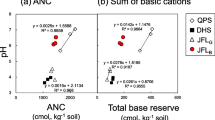Abstract
Background, Aim and Scope
Acid deposition has become a concern in south China in recent years. This phenomenon has increased to a dramatic extent with the large use of cars and coal- fueled power plants. As a consequence, soils are becoming acidified and their element dynamics will change. A decrease in the nutrient availability will lead to slower plant growth and maybe to a change in the forest type with current species being replaced by new ones with less nutrient requirements. Because of these reasons, it is important to understand how the dynamics of elements will change and what mechanism is part of the process. This knowledge is important for modeling the acidification process and either finding ways to counter it or to predict its consequences. The primary purpose of this study was to provide information about how the dynamics of K, Na, Ca, Mg and P are affected by acid deposition in a typical forest in southern China. Materials and Methods: Experimental soils and saplings were collected directly from the monsoon evergreen broad-leaved forest in Dinghushan. All saplings were transplanted individually into ceramic pots in August 2000 and placed in an open area near their origin site. Pot soils were treated weekly from October, 2000 to July, 2002 with an acidic solution at pH 3.05, pH 3.52, pH 4.00 or pH 4.40, or with tap water as a control. The concentrations of SO42-, NO3-, K+, Na+, Ca2+, Mg2+ and available P and the pH were measured in soil and leachate samples taken at different times. The sapling leaves were collected and their element concentrations were measured at the end of the experiment. Results: Concentrations of soil exchangeable Ca and Mg decreased quickly over time, although only Ca showed changes with the acidic solution treatment and soil exchangeable K was stable because of soil weathering. Leaching of K, Mg and Ca was dependent upon the treatment acidity. Soil available P decreased slowly without any correlation with the acidity of the treatment. All the NO3- added by the treatment was taken up by the plants, but the SO42- added accumulated in the soil. Discussion: Amongst the plant species, Schima superba was little affected by the treatment, the leaf P content was affected in Acmena acuminatissima plants and Cryptocarya concinna was the most susceptible species to soil acidification, with a marked decrease of the leaf K, Ca and Mg concentrations when the treatment acidity increased. Conclusions: Simulated acid deposition affected the dynamics of K, Ca and Mg in the monsoon evergreen broad-leaved forest. The dynamics of Ca in the soil and of K, Mg and Ca in the soil leachates were affected by the acidic solution treatment. If such a soil acidification occurs, Cryptocarya concinna will be amongst the first affected species, but Schima superba will be able to sustain a good growth and mineral nutrition. Recommendations and Perspectives: Acid deposition will lead to imbalance the nutrient elements in the evergreen broad-leaved forest because of accelerated leaching losses of soil exchangeable Ca and Mg. Measures should be developed to slow down soil acidification or nutrient decrease.
Similar content being viewed by others
Author information
Authors and Affiliations
Corresponding author
Rights and permissions
About this article
Cite this article
Liu, J. Simulated Effects of Acidic Solutions on Element Dynamics in Monsoon Evergreen Broad-leaved Forest at Dinghushan, China - Part 1: Dynamics of K, Na, Ca, Mg and P (7 pp). Env Sci Poll Res Int 14, 123–129 (2007). https://doi.org/10.1065/espr2006.07.325
Received:
Accepted:
Published:
Issue Date:
DOI: https://doi.org/10.1065/espr2006.07.325




